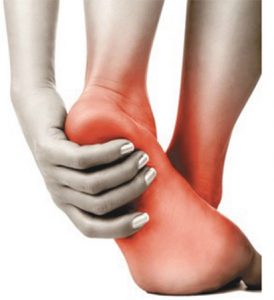By Premier Foot & Ankle Specialists


Our foot is meant to function in a “neutral position” and when it is in that “neutral position” there is less stress, strain and inflammation on the muscles, tendons, joints and ligaments of the foot. When the arch is supported and the heel is in a closed backed shoe, this “neutral position” can be obtained and sustained with weightbearing and activities. Our natural body weight wants to flatten out the arch when we stand causing a “un-neutral position” which causes unnecessary stress, strain and inflammation of the muscles, tendons, joints and ligaments of the foot causing muscles and tendon imbalances and progressive deformities and inflammatory conditions, like plantar fasciitis.
When the plantar fascia is subjected to prolonged periods of strain over time, it results in the tissue fibers of the fascia stretching or tearing, which leads to pain, inflammation, and potential bone spur formation where the fascia attaches to the heel bone. The most common symptoms that one may experience are stabbing pains in the heel, which usually occurs during the first steps in the morning or getting up after being seated for some time. This is due to the plantar fascial band shortening and contracting with long periods of inactivity. The pain that occurs after long periods of rest is a phenomenon known as “post-static dyskinesia.” Resuming activity and walking may temporarily lessen the heel pain as the band elongates and stretches out once again. However, symptoms will typically recur after prolonged rest or extensive activity.
Plantar fasciitis can be diagnosed by your podiatrist through obtaining a medical history and physical examination. X-rays may also be obtained, to rule out underlying pathology of the bone, such as fractures or cysts. Initial treatment options for plantar fasciitis can include, simple rest from excessive and repetitive impacts on the heel, such as running, jumping, and standing for prolonged periods of time. However, complete inactivity is not recommended either, as it can lead to stiffening of the plantar fascia and recurrence of pain. Stretching exercises to improve flexibility of the plantar fascia and calf muscles are also an essential key in alleviating symptoms of plantar fasciitis. Icing and massaging the plantar fascia can also help reduce pain and inflammation. Anti-inflammatory medications or injectable steroids may also be utilized to decrease inflammation. Your podiatrist may deem you to be candidate for physical therapy, which can utilize in depth stretching and strengthening exercises, gait assessment and gait training, splinting and taping, along with non-invasive treatments such as ultrasound iontophoresis and lasers in some cases.
A functional orthotic can also be made for correcting biomechanical abnormalities, preventing excessive pronation, and providing maximal support to the soft tissue structures that comprise the plantar fascia. Orthotics effectively treat the majority of heel and arch pain without the need of more invasive interventions, like surgery. Your podiatrist can design a custom orthotic that is unique to your foot anatomy and activity needs.
In rare cases of chronic plantar fasciitis that is not responsive to conservative methods, surgery may be indicated, which may entail a release of the plantar fascia utilizing a number of methods.
A variety of preventative methods can be taken to avoid plantar fasciitis and its associated symptoms. Wearing shoes that are properly fitted with supportive rigid soles that are shock-absorbent, with strong heel counters are particularly effective. Pairing these shoes with a high quality, medical-grade, orthotic will also provide significant benefit. Replace shoes when appropriate given your individual activity level and never wear shoes with excessive wear on the heels or soles. Warm-up exercises and stretches are essential before engaging in exercise and giving your body the proper rest afterwards. Maintaining a healthy body weight through good nutrition and physical activity is also essential.
All of the methods mentioned above will help prevent the occurrence of plantar fasciitis and maintain overall good foot health. However, if painful symptoms persist along with other signs of inflammation such as redness, swelling, and warmth, please contact your local podiatrist today to be evaluated and treated.
Dr. Brielle Roggow
Dr. Brielle Roggow was born and raised in Jackson, Minnesota. She attended and graduated from Minnesota State University, Mankato, with a Bachelor of Science in biology. Next, she moved to Cleveland, Ohio where she attended Kent State University of Podiatric Medicine and graduated in the top 10% of her class. Following medical school, she moved to Tampa, Florida where she completed her surgical residency with the James A. Haley Veterans Hospital.
Dr. Roggow is excited to provide exceptional foot and ankle care to Southwest Florida. Her podiatric interests include reconstructive surgery, wound care, trauma, and day-to-day podiatric care. Dr. Roggow enjoys spending her free time with her family. She is married to her husband Joshua and has a son, Jett, a daughter Josie, and two stepdaughters, Rylee and Reese. She enjoys being outdoors on the water, cooking, gardening, and riding horses.
Dr. Jeremy Bonjorno
Dr. Jeremy Bonjorno was born in Dansville, New York. He graduated from University of South Florida with a Bachelor of Science in Biomedical Sciences. Dr. Bonjorno received a Doctorate of Podiatric Medicine from Kent State University in Ohio. He completed a three-year surgical residency at the James A. Haley Veteran’s Hospital in Tampa, where he served America’s veterans.
Dr. Bonjorno is a community-focused podiatrist with a commitment to high-quality patient care. His podiatric interests include diabetic foot care, wound care, bunions, hammertoes, neuromas, and plantar fasciitis. In his free time, he enjoys spending time with his friends and family in Tampa. He also likes music, cars, traveling, and cycling.
Premier Foot and Ankle
(941) 488-0222
4120 Woodmere Park Blvd, Suite 5, Venice, FL 34293
 Southwest Florida's Health and Wellness Magazine Health and Wellness Articles
Southwest Florida's Health and Wellness Magazine Health and Wellness Articles

